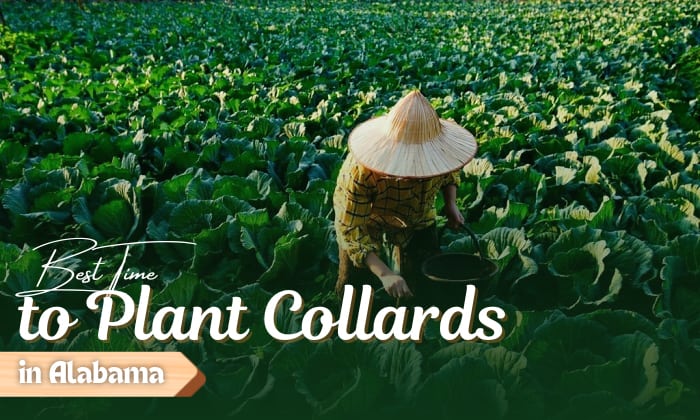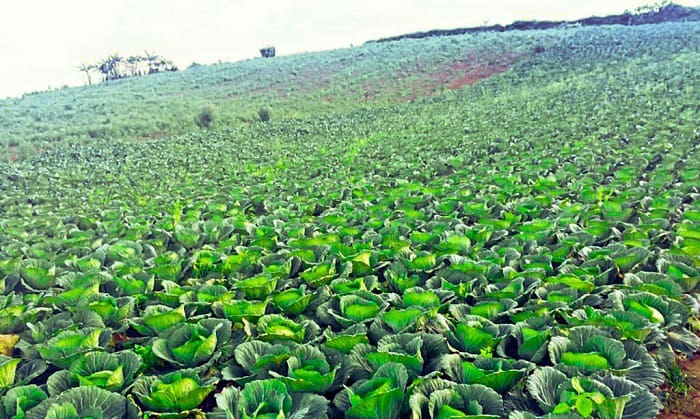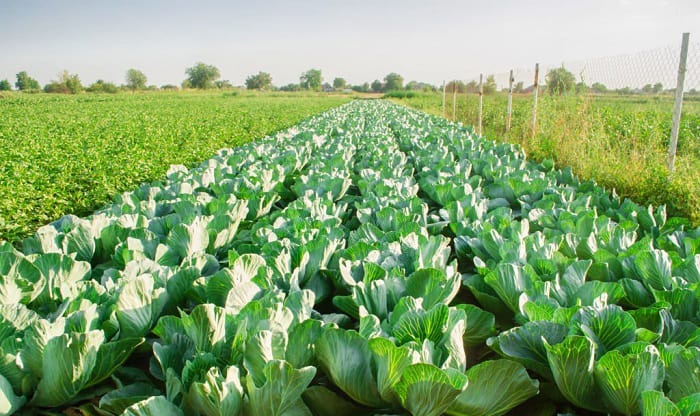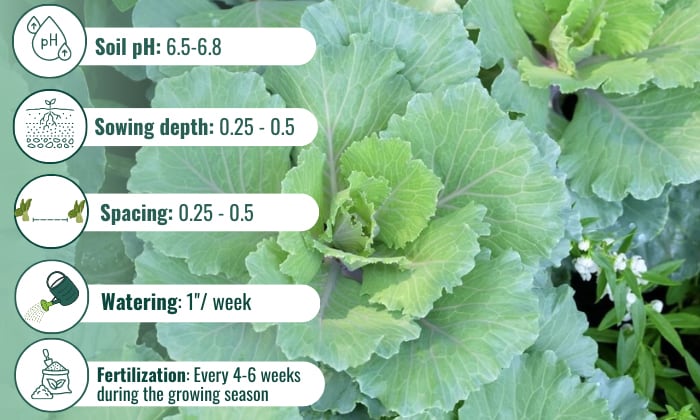Are you eager to cultivate your own vibrant and nutrient-packed collard greens? Knowing the optimal time for planting is key to a successful harvest.
So, when to plant collards in Alabama? The ideal time is from the 15th of July until mid-September for a bountiful harvest before colder temperatures arrive. It is usually 6 – 8 weeks before the first frost when the temperature is not too hot.
Table of Contents
Best Time to Plant Collards in Alabama
This green variety grows quickly, maturing in 60 to 80 days when growing collards from seeds. Since Alabama is situated in Zones 7b to 8b, plants in this area can handle a minimum average temperature of 5° to 20°F, ideal for collards.
Growing collards in summer is fine. This is a sun-loving plant. The sun can catalyze collards to grow bigger and remain undamaged during cold, harsh days.
When you want to harvest in the winter or in the fall, one of the best times to plant collard greens in Alabama is in late summer.
It is usually 6 – 8 weeks before the first frost when the temperature is not too hot. The ideal plan should be:
- Grow seeds from the 1st of July – the 1st of August into plant pots.
- Transplant the greens into the garden soil 3 – 4 weeks later (around 1st Augst – 1st September).
- Harvesting will be in the winter month, right when the frost comes. It will be 60 – 75 days after transplanting.
Planting Collards Seeds in Different Areas of Alabama
You can use this frost date chart as a reference to know when the best planting dates for your collards are.
| City | First Frost Date | Growing Season | Planting time |
| Alabaster | November 2 | 217 days | August 2 – August 15 |
| Bay Minette | November 17 | 252 days | July 17 – August 2 |
| Cullman | Octocber 27 | 200 days | July 27 – August 13 |
| Demopolis | November 7 | 228 days | August 7 – August 21 |
| Eufaula | November 9 | 233 days | August 9 – August 23 |
| Florence | October 30 | 209 days | July 30 – August 15 |
| Greenville | November 13 | 240 days | July 13 – August 1 |
| Jasper | October 30 | 207 days | July 30 – August 15 |
| Troy | November 12 | 238 days | August 12 – August 30 |
| Valley | November 3 | 213 days | August 3 – August 18 |
Throughout the collard’s growing season, it can grow in the soil at 45 to 85 degrees Fahrenheit. Cultivating this vegetable in Alabama would be ideal, especially in its warmest cities. Here is the daily mean temperature table to use as a plants guide:
| City | Temperature |
| Gulf Shores | 69 °F |
| Orange Beach | 68 °F |
| Dothan | 67.85 °F |
| Mobile | 67.6 °F |
| Daphne | 67.5 °F |
| Atmore | 67.45 °F |
| Bay Minette | 69 °F |
| Headland | 67 °F |
| Eufaula | 66.55 °F |
| Enterprise | 66.35 °F |
Planting Collards at Home
In Alabama, when to plant collards depends on the specific state you belong to. However, as a rule of thumb, this type of vegetable is considered a cool-season crop and can be planted indoors and outdoors.
1. Indoor
Try planting collard seeds, calculate seven weeks before the last frost date. Use a small container or seed trays with potting mix. After the seedlings grow true leaves and reach 3-4 inches, transplant them to a larger container or garden bed. Provide warmth and light by placing them near a sunny window or using grow lights.
2. Outdoor
Collards thrive in cooler temperatures and can withstand light frosts. In Alabama, sow seeds in late summer for a fall harvest.
How Late Can I Plant Collards in Alabama?
Collards need cool temperatures to thrive and benefit from light frosts. Planting them late may require additional time to mature before harsh winter conditions.
To find the latest planting date for collards, subtract the recommended days to maturity from the average date of the first frost in your area. This provides an approximate latest possible planting date.
For example
- Area: Valley
- Average First Frost Date: Nov 3
- Collard Variety: Blue Collards
- Days to Maturity: 75 days
If we count 75 days backward from November 3, your estimated planting date should fall around August 21.
Best Collards to Plant in Alabama
In Alabama, several collard varieties are well-suited to the region’s growing conditions. Here are a few popular collard varieties that thrive in Alabama:
1. Georgia Southern(also known as ‘Georgia Collard’)
- widely grown and reliable, with large, dark green, and tender leaves.
- Heat tolerant and resistant to bolting.
2. Vates
- a popular choice with dark blue-green, slightly crinkled leaves. Exceptional flavor and tenderness, resistant to bolting.
- performs well in both spring and fall plantings.
3. Flash
- known for quick growth and excellent flavor
- produces dark green, smooth leaves with slight savoy
- highly resistant to bolting, ideal for Alabama’s climate
4. Morris Heading
- forms a tight, compact head of dark green leaves
- popular for its sweet and tender flavor
- heat tolerant and resistant to bolting.
5. Alabama Blue Collard
- well-adapted to Alabama’s growing conditions
- heat tolerant, and thrives in hot summers
- fairly resistant to bolting, allowing for an extended harvest period.
Tips to Consider for a Successful Collard Planting in Alabama
While Alabama has a suitable climate to grow collards, they may have better climates. Since collards are considered cool-season crops, the mild winter in Alabama is excellent, yet; the hot summers may not be ideal for this type of green.
However, successfully growing collards in Alabama can still be possible with proper cultivation and considering factors other than temperature.
1. Soil Type
Collards thrive in soil with good drainage with a ph between 6.5 and 6.8. This implies incorporating organic material, such as farm manure and compost, into your soil. Doing so will prevent excessive water retention, which is not ideal for collards.
2. Watering
Water is crucial for collard growth, especially in dry planting periods. Maintain consistent moisture, aiming for 1 inch of water per week. You can use drip irrigation or soaker hoses.
3. Spacing
Sow the seeds about ¼ to ½ inch deep. Collard plant spacing should be around 12 to 18 inches apart. Water the newly planted seeds gently and consistently to keep the soil moist until germination occurs.
4. Fertilization
Collards are heavy feeders and benefit from regular fertilization. Mix balanced fertilizer or compost into the soil before planting. Side-dress with nitrogen-rich fertilizer every 4-6 weeks during the growing season.
5. Pest and disease management
Be vigilant for pests like cabbage loopers. Prevent diseases by rotating crops, spacing plants adequately, and promptly removing infected material. Try organic pest control methods such as neem oil or insecticidal soap.
Harvesting Collards in Alabama
- Harvest collards around 60-80 days after planting. Start with outer leaves at 8-10 inches long. Regularly harvest outer leaves to stimulate continuous growth and prevent woody plants.
- Avoid harvesting more than one-third of the plant at a time to allow for continuous growth and avoid stunting the plant’s development.
- Use a sharp knife or garden shear to cut the leaves off at the base of the stem, ensuring a clean cut. Avoid tearing the leaves, as this can lead to damage and potential rot.
- Regularly inspect the plants. Remove any damaged or infested leaves promptly to prevent the spread of issues to healthy foliage.
Conclusion
I hope this guide has shed a “green” light on when to plant collards in Alabama. So grab your gardening gloves and get ready to enjoy leafy goodness straight from your backyard!
Remember, harvesting collards at the right time and with proper techniques ensures the best flavor and quality for your culinary delights.

Hi, I am William – Floridayards’ digital content creator. My job is to find answers to all your concerns with thorough research and our team’s expert advice. I will also bring you honest reviews on the best products and equipment for raising your beautiful garden. Please look forward to our work!
















